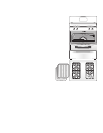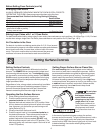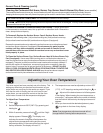
6
Setting Surface Controls
Do not place
plastic items such as salt
and pepper shakers,
spoon holders or plastic
wrappings on top of the
range when it is in use.
These items could melt or
ignite. Potholders, towels or
wood spoons could catch
fire if placed too close to a
flame.
Setting Proper Surface Burner Flame Size
For most cooking
start on the highest control setting &
then turn to a lower one to complete the process. Use the
recommendations below as a guide for determining proper
flame size for various types of cooking. The size & type of
utensil used & the amount of food being cooked will
influence the setting needed for cooking. Use a high flame
to start most foods; bring water to a boil or pan broiling. Use
a medium flame to maintain a slow boil; thicken sauces,
gravies or steaming. Use a low flame to keep foods
cooking; poaching or stewing.
Setting Surface Controls
Your range may be equipped with different sized surface
burners. The SIMMER burner (some models) is best used
for simmering delicate sauces, etc. The standard burners
can be used for most surface cooking needs. The POWER
PLUS burner(s) (some models) are best suited for bringing
large quantities of liquid to temperature & when preparing
larger quantities of food.
Regardless of size, always select cookware that is suitable
for the amount and type of food being prepared. Select a
burner & flame size appropriate to the pan. Never allow
flames to extend beyond the outer edge of the pan.
Operating the Gas Surface Burners:
1. Place cooking utensil on surface burner.
2. Push the surface control knob in and turn
counterclockwise out of the OFF position.
3. Release the knob and rotate to the LITE position. Note:
All four electronic surface ignitors will spark at the same
time. However, only the burner you are turning on will
ignite (Refer to Fig. 4).
3. Visually check that the burner has lit.
4. Push the control knob in & turn counterclockwise to
the desired flame size. The surface control knobs do
not have to be set at a particular setting. Use the
guides & adjust the flame as needed. DO NOT cook
with the surface control knob in the LITE position. (The
electronic ignitor will continue to spark if the knob is left
in the LITE position.)
In the event of an electrical power outage, the surface
burners can be lit manually. To light a surface burner, hold a
lit match to the burner head, then slowly turn the surface
control knob to LITE. After burner lights push in & turn knob
to desired setting. Use caution when lighting surface
burners manually.
Fig. 4
For best air circulation and baking results allow 2-4" (5-10 cm) around
the cookware for proper air circulation and be sure pans and cookware
do not touch each other, the oven door, sides or back of the oven
cavity. The hot air must be able to circulate around the pans and
cookware in the oven for even heat to reach around the food.
Air Circulation in the Oven
Fig. 2
Fig. 3
Baking Layer Cakes with 1 or 2 Oven Racks
For best results when baking cakes using 2 oven racks, place cookware on rack positions 1 & 4 (See Figs. 1 & 2). For best
results when using a single oven Flat Rack, place cookware on rack position 2 or 3 (See Figs. 1 & 3).
Fig. 1
Before Setting Oven Controls (cont’d)
Recommended Rack Positions for Broiling, Baking & Roasting:
Food Rack Position
Broiling hamburgers & steaks
Broiling meats, chicken or fish
Cookies, cakes, pies, biscuits & Muffins
Frozen pies, angel food cake, yeast, bread, casseroles,
small cuts of meat or poultry
Turkey, roast or ham
Arranging Oven Racks
ALWAYS ARRANGE OVEN RACKS WHEN THE OVEN IS COOL (PRIOR TO
OPERATING THE OVEN).
Always use oven mitts when using the oven.
See Broil section
See Broil section
2 or 3
1 or Roasting Shelf
Roasting
Shelf
5
4
3
2
1


















